2006 BMW Z4 3.0SI ROADSTER child restraint
[x] Cancel search: child restraintPage 32 of 128
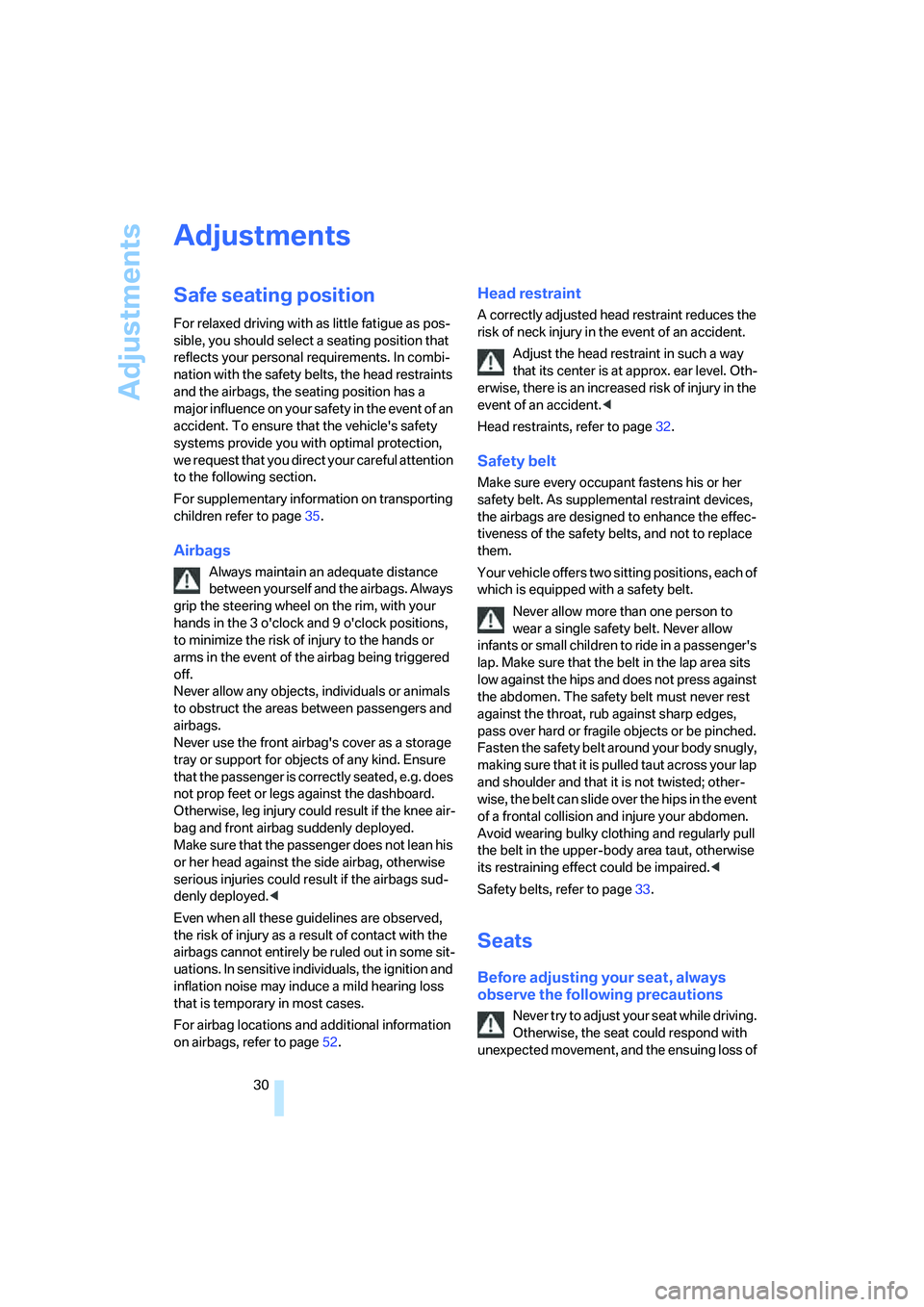
Adjustments
30
Adjustments
Safe seating position
For relaxed driving with as little fatigue as pos-
sible, you should select a seating position that
reflects your personal requirements. In combi-
nation with the safety belts, the head restraints
and the airbags, the seating position has a
major influence on your safety in the event of an
accident. To ensure that the vehicle's safety
systems provide you with optimal protection,
we request that you direct your careful attention
to the following section.
For supplementary information on transporting
children refer to page35.
Airbags
Always maintain an adequate distance
between yourself and the airbags. Always
grip the steering wheel on the rim, with your
hands in the 3 o'clock and 9 o'clock positions,
to minimize the risk of injury to the hands or
arms in the event of the airbag being triggered
off.
Never allow any objects, individuals or animals
to obstruct the areas between passengers and
airbags.
Never use the front airbag's cover as a storage
tray or support for objects of any kind. Ensure
that the passenger is correctly seated, e.g. does
not prop feet or legs against the dashboard.
Otherwise, leg injury could result if the knee air-
bag and front airbag suddenly deployed.
Make sure that the passenger does not lean his
or her head against the side airbag, otherwise
serious injuries could result if the airbags sud-
denly deployed.<
Even when all these guidelines are observed,
the risk of injury as a result of contact with the
airbags cannot entirely be ruled out in some sit-
uations. In sensitive individuals, the ignition and
inflation noise may induce a mild hearing loss
that is temporary in most cases.
For airbag locations and additional information
on airbags, refer to page52.
Head restraint
A correctly adjusted head restraint reduces the
risk of neck injury in the event of an accident.
Adjust the head restraint in such a way
that its center is at approx. ear level. Oth-
erwise, there is an increased risk of injury in the
event of an accident.<
Head restraints, refer to page32.
Safety belt
Make sure every occupant fastens his or her
safety belt. As supplemental restraint devices,
the airbags are designed to enhance the effec-
tiveness of the safety belts, and not to replace
them.
Your vehicle offers two sitting positions, each of
which is equipped with a safety belt.
Never allow more than one person to
wear a single safety belt. Never allow
infants or small children to ride in a passenger's
lap. Make sure that the belt in the lap area sits
low against the hips and does not press against
the abdomen. The safety belt must never rest
against the throat, rub against sharp edges,
pass over hard or fragile objects or be pinched.
F a s t e n t he s a f e t y b e l t a ro u n d y o u r b o d y s n u g l y,
ma king sure tha t it is pulled taut across your lap
and shoulder and that it is not twisted; other-
wise, the belt can slide over the hips in the event
of a frontal collision and injure your abdomen.
Avoid wearing bulky clothing and regularly pull
the belt in the upper-body area taut, otherwise
its restraining effect could be impaired.<
Safety belts, refer to page33.
Seats
Before adjusting your seat, always
observe the following precautions
Never try to adjust your seat while driving.
Otherwise, the seat could respond with
unexpected movement, and the ensuing loss of
Page 37 of 128
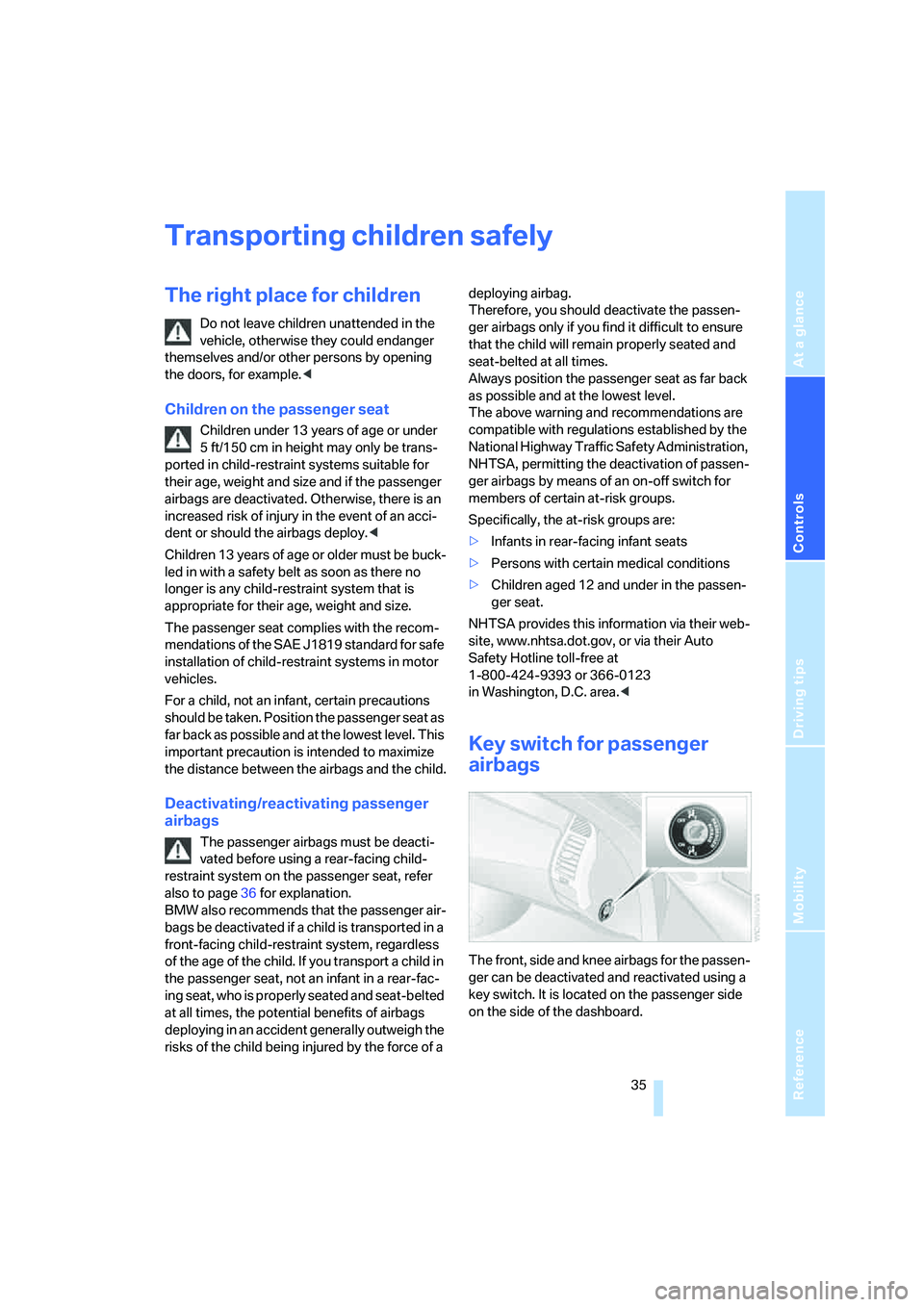
Reference
At a glance
Controls
Driving tips
Mobility
35
Transporting children safely
The right place for children
Do not leave children unattended in the
vehicle, otherwise they could endanger
themselves and/or other persons by opening
the doors, for example.<
Children on the passenger seat
Children under 13 years of age or under
5ft/150cm in height may only be trans-
ported in child-restraint systems suitable for
their age, weight and size and if the passenger
airbags are deactivated. Otherwise, there is an
increased risk of injury in the event of an acci-
dent or should the airbags deploy.<
Children 13 years of age or older must be buck-
led in with a safety belt as soon as there no
longer is any child-restraint system that is
appropriate for their age, weight and size.
The passenger seat complies with the recom-
mendations of the SAE J1819 standard for safe
installation of child-restraint systems in motor
vehicles.
For a child, not an infant, certain precautions
should be taken. Position the passenger seat as
far back as possible and at the lowest level. This
important precaution is intended to maximize
the distance between the airbags and the child.
Deactivating/reactivating passenger
airbags
The passenger airbags must be deacti-
vated before using a rear-facing child-
restraint system on the passenger seat, refer
also to page36 for explanation.
BMW also recommends that the passenger air-
bags be deactivated if a child is transported in a
front-facing child-restraint system, regardless
of the age of the child. If you transport a child in
the passenger seat, not an infant in a rear-fac-
ing seat, who is properly seated and seat-belted
at all times, the potential benefits of airbags
deploying in an accident generally outweigh the
risks of the child being injured by the force of a deploying airbag.
Therefore, you should deactivate the passen-
ger airbags only if you find it difficult to ensure
that the child will remain properly seated and
seat-belted at all times.
Always position the passenger seat as far back
as possible and at the lowest level.
The above warning and recommendations are
compatible with regulations established by the
National Highway Traffic Safety Administration,
NHTSA, permitting the deactivation of passen-
ger airbags by means of an on-off switch for
members of certain at-risk groups.
Specifically, the at-risk groups are:
>Infants in rear-facing infant seats
>Persons with certain medical conditions
>Children aged 12 and under in the passen-
ger seat.
NHTSA provides this information via their web-
site, www.nhtsa.dot.gov, or via their Auto
Safety Hotline toll-free at
1-800-424-9393 or 366-0123
in Washington, D.C. area.<
Key switch for passenger
airbags
The front, side and knee airbags for the passen-
ger can be deactivated and reactivated using a
key switch. It is located on the passenger side
on the side of the dashboard.
Page 38 of 128
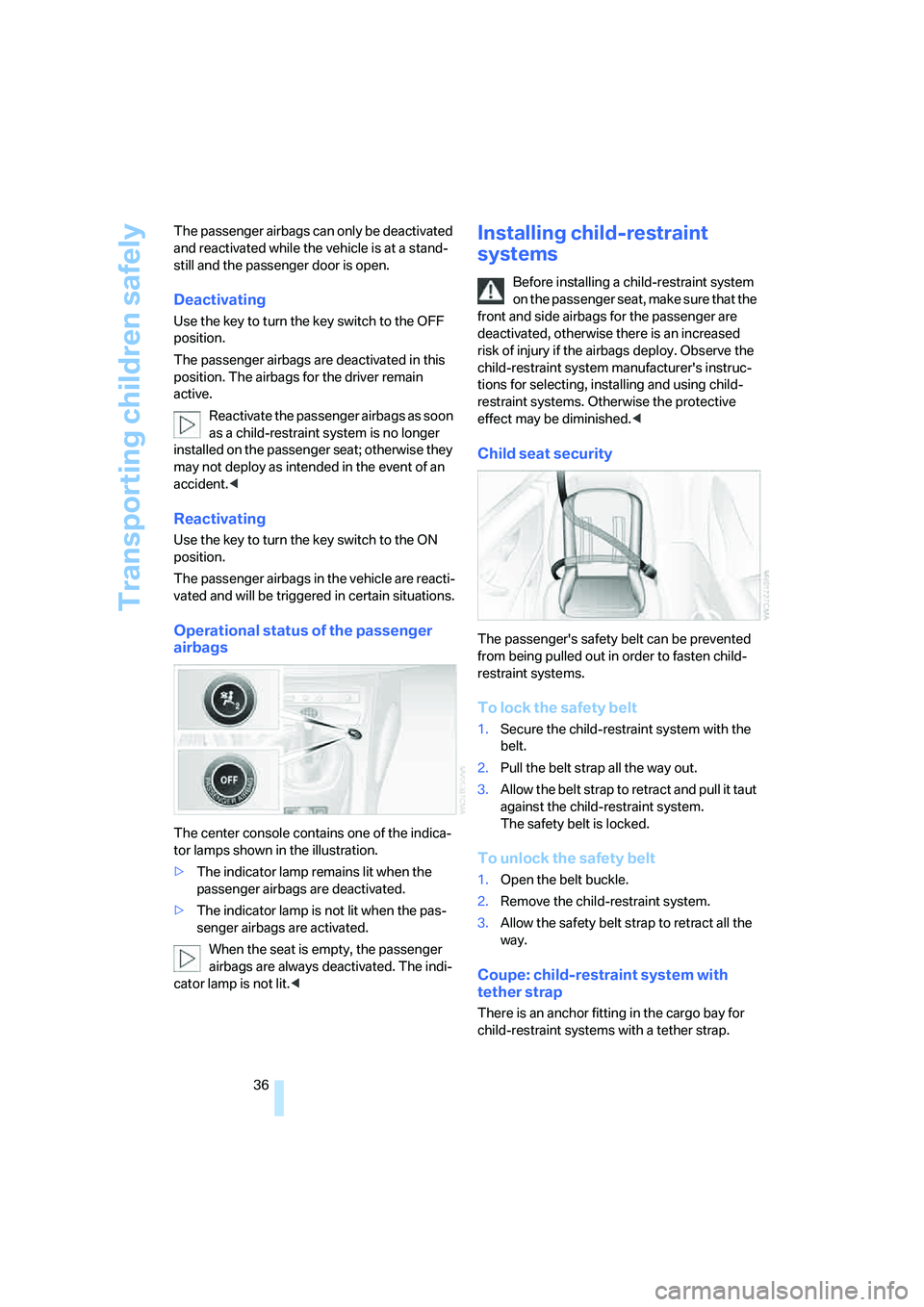
Transporting children safely
36 The passenger airbags can only be deactivated
and reactivated while the vehicle is at a stand-
still and the passenger door is open.
Deactivating
Use the key to turn the key switch to the OFF
position.
The passenger airbags are deactivated in this
position. The airbags for the driver remain
active.
Reactivate the passenger airbags as soon
as a child-restraint system is no longer
installed on the passenger seat; otherwise they
may not deploy as intended in the event of an
accident.<
Reactivating
Use the key to turn the key switch to the ON
position.
The passenger airbags in the vehicle are reacti-
vated and will be triggered in certain situations.
Operational status of the passenger
airbags
The center console contains one of the indica-
tor lamps shown in the illustration.
>The indicator lamp remains lit when the
passenger airbags are deactivated.
>The indicator lamp is not lit when the pas-
senger airbags are activated.
When the seat is empty, the passenger
airbags are always deactivated. The indi-
cator lamp is not lit.<
Installing child-restraint
systems
Before installing a child-restraint system
on the passenger seat, make sure that the
front and side airbags for the passenger are
deactivated, otherwise there is an increased
risk of injury if the airbags deploy. Observe the
child-restraint system manufacturer's instruc-
tions for selecting, installing and using child-
restraint systems. Otherwise the protective
effect may be diminished.<
Child seat security
The passenger's safety belt can be prevented
from being pulled out in order to fasten child-
restraint systems.
To lock the safety belt
1.Secure the child-restraint system with the
belt.
2.Pull the belt strap all the way out.
3.Allow the belt strap to retract and pull it taut
against the child-restraint system.
The safety belt is locked.
To unlock the safety belt
1.Open the belt buckle.
2.Remove the child-restraint system.
3.Allow the safety belt strap to retract all the
way.
Coupe: child-restraint system with
tether strap
There is an anchor fitting in the cargo bay for
child-restraint systems with a tether strap.
Page 39 of 128
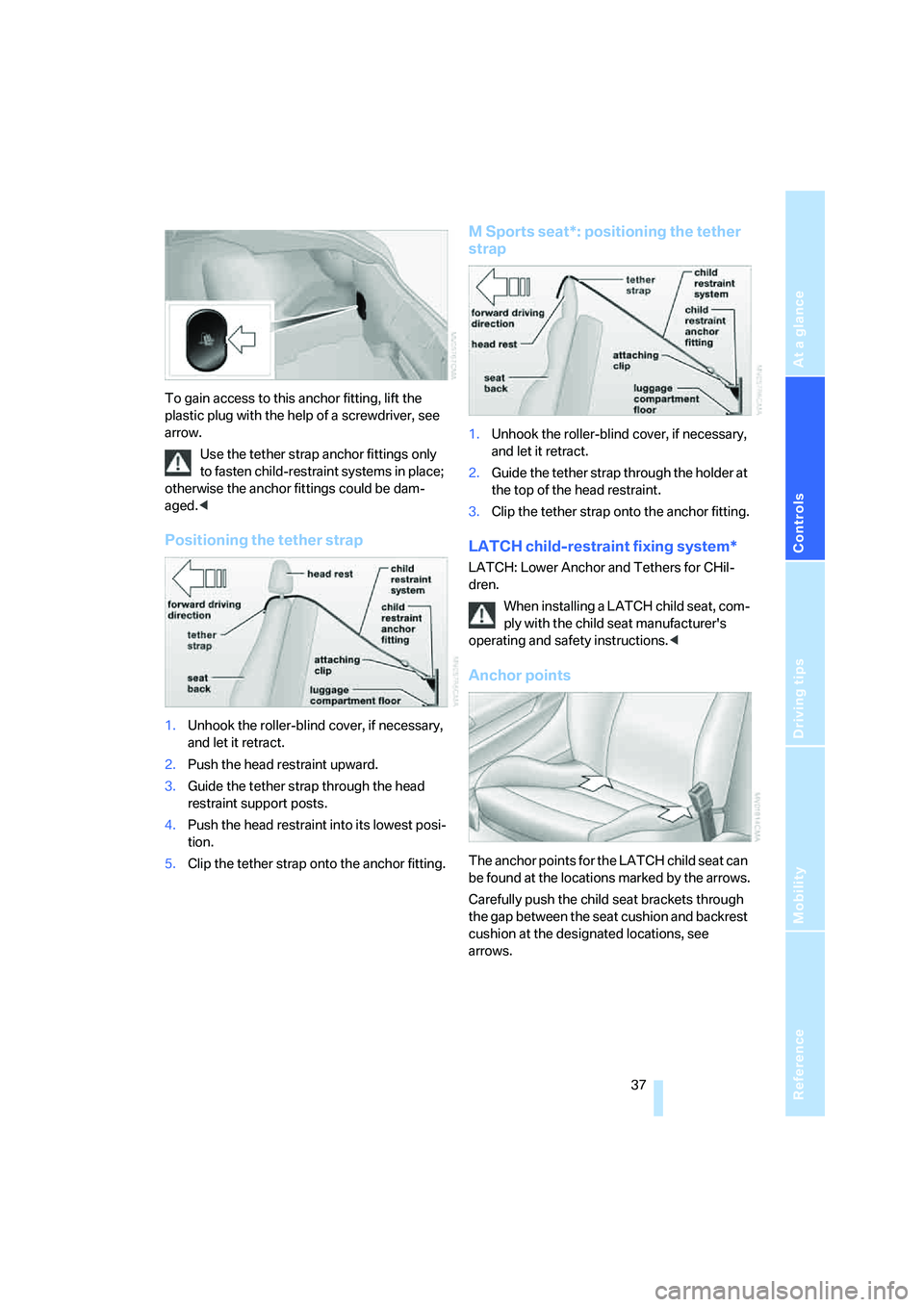
Reference
At a glance
Controls
Driving tips
Mobility
37
To gain access to this anchor fitting, lift the
plastic plug with the help of a screwdriver, see
arrow.
Use the tether strap anchor fittings only
to fasten child-restraint systems in place;
otherwise the anchor fittings could be dam-
aged.<
Positioning the tether strap
1.Unhook the roller-blind cover, if necessary,
and let it retract.
2.Push the head restraint upward.
3.Guide the tether strap through the head
restraint support posts.
4.Push the head restraint into its lowest posi-
tion.
5.Clip the tether strap onto the anchor fitting.
M Sports seat*: positioning the tether
strap
1.Unhook the roller-blind cover, if necessary,
and let it retract.
2.Guide the tether strap through the holder at
the top of the head restraint.
3.Clip the tether strap onto the anchor fitting.
LATCH child-restraint fixing system*
LATCH: Lower Anchor and Tethers for CHil-
dren.
When installing a LATCH child seat, com-
ply with the child seat manufacturer's
operating and safety instructions.<
Anchor points
The anchor points for the LATCH child seat can
be found at the locations marked by the arrows.
Carefully push the child seat brackets through
the gap between the seat cushion and backrest
cushion at the designated locations, see
arrows.
Page 55 of 128
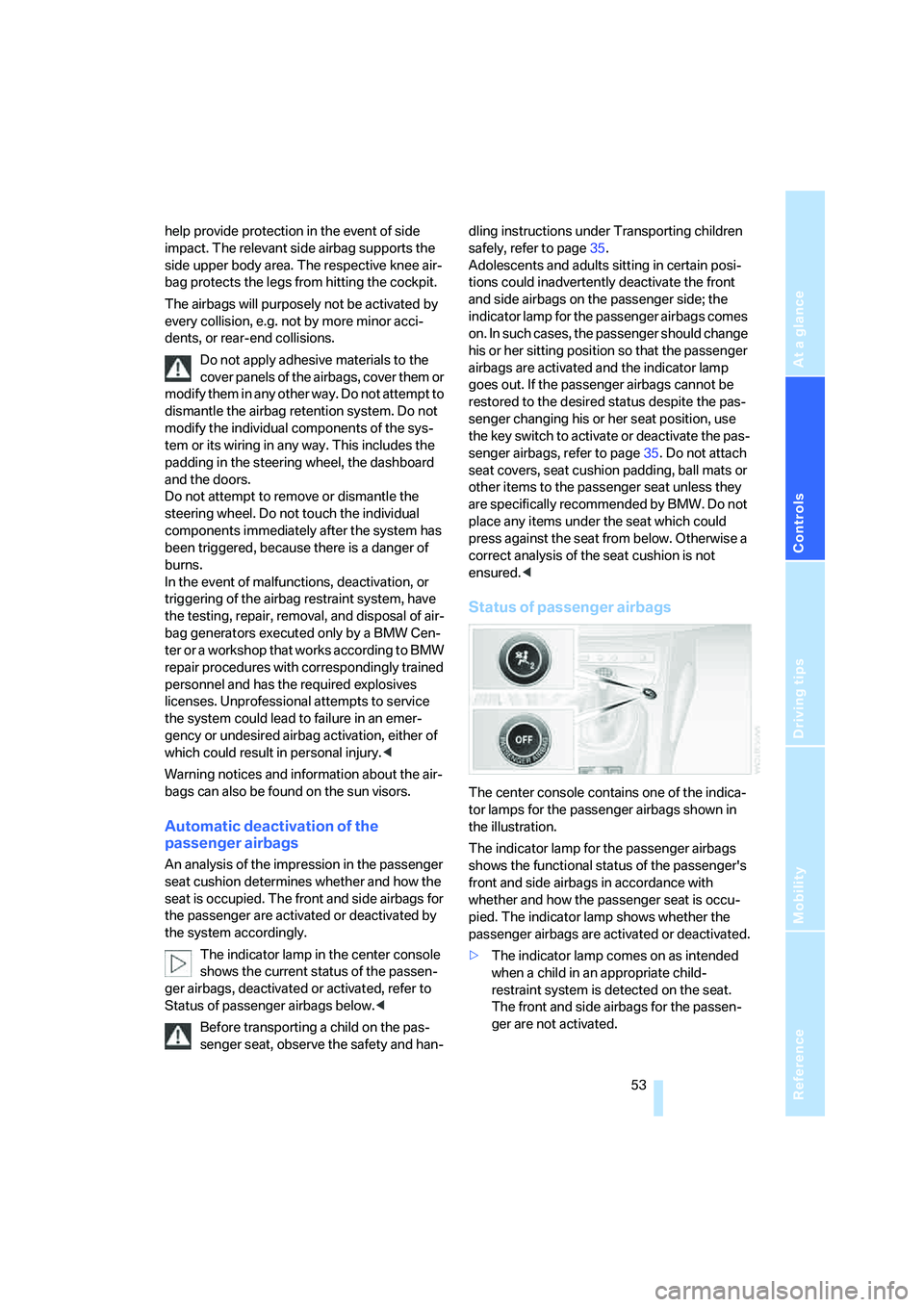
Reference
At a glance
Controls
Driving tips
Mobility
53
help provide protection in the event of side
impact. The relevant side airbag supports the
side upper body area. The respective knee air-
bag protects the legs from hitting the cockpit.
The airbags will purposely not be activated by
every collision, e.g. not by more minor acci-
dents, or rear-end collisions.
Do not apply adhesive materials to the
cover panels of the airbags, cover them or
modify them in any other way. Do not attempt to
dismantle the airbag retention system. Do not
modify the individual components of the sys-
tem or its wiring in any way. This includes the
padding in the steering wheel, the dashboard
and the doors.
Do not attempt to remove or dismantle the
steering wheel. Do not touch the individual
components immediately after the system has
been triggered, because there is a danger of
burns.
In the event of malfunctions, deactivation, or
triggering of the airbag restraint system, have
the testing, repair, removal, and disposal of air-
bag generators executed only by a BMW Cen-
ter or a workshop that works according to BMW
repair procedures with correspondingly trained
personnel and has the required explosives
licenses. Unprofessional attempts to service
the system could lead to failure in an emer-
gency or undesired airbag activation, either of
which could result in personal injury.<
Warning notices and information about the air-
bags can also be found on the sun visors.
Automatic deactivation of the
passenger airbags
An analysis of the impression in the passenger
seat cushion determines whether and how the
seat is occupied. The front and side airbags for
the passenger are activated or deactivated by
the system accordingly.
The indicator lamp in the center console
shows the current status of the passen-
ger airbags, deactivated or activated, refer to
Status of passenger airbags below.<
Before transporting a child on the pas-
senger seat, observe the safety and han-dling instructions under Transporting children
safely, refer to page35.
Adolescents and adults sitting in certain posi-
tions could inadvertently deactivate the front
and side airbags on the passenger side; the
indicator lamp for the passenger airbags comes
on. In such cases, the passenger should change
his or her sitting position so that the passenger
airbags are activated and the indicator lamp
goes out. If the passenger airbags cannot be
restored to the desired status despite the pas-
senger changing his or her seat position, use
the key switch to activate or deactivate the pas-
senger airbags, refer to page35. Do not attach
seat covers, seat cushion padding, ball mats or
other items to the passenger seat unless they
are specifically recommended by BMW. Do not
place any items under the seat which could
press against the seat from below. Otherwise a
correct analysis of the seat cushion is not
ensured.<
Status of passenger airbags
The center console contains one of the indica-
tor lamps for the passenger airbags shown in
the illustration.
The indicator lamp for the passenger airbags
shows the functional status of the passenger's
front and side airbags in accordance with
whether and how the passenger seat is occu-
pied. The indicator lamp shows whether the
passenger airbags are activated or deactivated.
>The indicator lamp comes on as intended
when a child in an appropriate child-
restraint system is detected on the seat.
The front and side airbags for the passen-
ger are not activated.
Page 116 of 128

Everything from A to Z
114 Changes, technical, refer to
For your own safety5
Changing a wheel96
– Run-Flat Tires96
Charge indicator lamp12,97
Check gas cap, indicator
lamp13
Child-restraint mounting
system, LATCH37
Child-restraint systems36
Child seat, refer to Installing
child-restraint systems36
Chrome parts, refer to the
Caring for your vehicle
brochure
Cigarette lighter65
Cleaning the rear window,
refer to the Caring for your
vehicle brochure
Cleaning the vehicle, refer to
the Caring for your vehicle
brochure
Cleaning the windows
– automatically, refer to Rain
sensor43
– reservoir capacity110
– spray nozzles44
– washer/wiper system43
– washer fluid44
– washer fluid reservoir44
Clock47
– 12h/24h mode48
– onboard computer48
– setting48
– setting, refer also to Owner's
Manual for Radio/Onboard
Computer
Clothes hooks66
Cockpit10
Cold start, refer to Starting the
engine38
Comfort area, refer to Around
the center console14
Compact disc operation, refer
to Owner's Manual for
Radio/Onboard ComputerComputer48
– button BC48
– clock, 12h/24h mode48
– refer to Owner's Manual for
Onboard Computer
Computer, refer to the
separate Owner's Manual
Condensation, refer to When
the vehicle is parked72
Condensation, removing from
windows
– air conditioning59
– automatic climate control62
Configuring settings, refer to
Vehicle Memory, Key
Memory18
Connecting vacuum cleaner,
refer to Connecting
electrical appliances67
Consumption, refer to
Average fuel
consumption48
Consumption display, refer to
Fuel gauge46
Controls, refer to Cockpit10
Convenience operation
– convertible top20
– from outside20
– windows20
Convertible top26,27
– care, refer to the Caring for
your vehicle brochure
– convenience operation20
– electrical fault28
– emergency closing28
– fully automatic27
– malfunction28
– manual26
– mechanical26
Convertible top compartment
panel23
Coolant89
– checking level89
– indicator lamp13
– thermometer47
Coolant water, refer to
Coolant89Cooling
– maximum62
– refer to Switching cooling
function on/off59,62
Cooling fluid, refer to
Coolant89
Cooling function
– air conditioning59
– automatic climate control62
Cooling system, refer to
Capacities110
Copyright2
Correct tires84
Cruise control44
Cruising range48
Cup holders, refer to
Beverage holders65
Curb weight, refer to
Weights109
Cylinders, refer to Engine
data106D
Dashboard, refer to
Cockpit10
Dashboard lighting, refer to
Instrument lighting56
Data, technical
– capacities110
– dimensions107,108
– engine106
– measurements107,108
– weights109
Daytime running light55
DBC Dynamic Brake
Control49
– indicator/warning lamp13
Deadlocking, refer to
Locking19
Defective bulb55
Defrosting, windows59,62
Defrosting the windshield,
refer to Defrosting
windows59,62
Defrosting windows and
removing condensation
– air conditioning59
– automatic climate control62
Page 119 of 128

Reference
At a glance
Controls
Driving tips
Mobility
117
Height adjustment
– seats31
– steering wheel34
High beams56
– bulb replacement94
– headlamp flasher42
– indicator lamp12
High temperatures70
Holders for beverages65
Homepage BMW4
Hood86
Horn10
Hot exhaust system70
Hydraulic Brake Assistant,
refer to Dynamic Brake
Control DBC49
Hydraulics, brake90
Hydroplaning71
I
Ice warning, refer to Outside
temperature warning46
Identification mark
– Run-Flat Tires84
– tire coding82
– tires84,85
Ignition, refer to Ignition
switched on38
Ignition key positions, refer to
Ignition lock38
Ignition keys, refer to The key
set18
Ignition lock38
Imprint2
Inclines71Indicator/warning lamp12
– airbags54
– alarm system24
– automatic transmission with
Steptronic41
– brakes13
– coolant temperature47
– DSC49
– DTC50
– engine oil level87
– engine oil pressure87
– engine temperature47
– fasten safety belts33
– Flat Tire Monitor51
– passenger airbags36
– reserve46
Indicator and warning lamps,
overview12
Individual vehicle
– equipment, refer to Your
individual vehicle5
Inflation pressure, refer to Tire
inflation pressure80
Inflation pressure monitoring,
refer to
– Flat Tire Monitor51
– Tire inflation pressure80
Initializing
– Flat Tire Monitor FTM51
– windows25
Inspection47
Instrument cluster12
Instrument lighting56
Instrument panel, refer to
Cockpit10
Instrument panel, refer to
Instrument cluster12
Interior lamps56
– remote control19
Interior motion sensor24
Interior rearview mirror34
– automatic dimming
feature
71
Interior temperature
adjusting59,62
Interlock, refer to Steering
locked38,40
Intermittent
– operation of the wipers43Interval
– display, service47
J
Jack96
Jacking points97
Jets, refer to
Ventilation59,63
Jump-starting99
K
Key Memory18
Keys18
Keys, refer to The key set18
Key switch for passenger
airbags35
Kickdown41
Knee airbags52
Knock control79
L
Lamps55
Lamps and bulbs93
LATCH, child-restraint
mounting system37
Leather care, refer to the
Caring for your vehicle
brochure
LEDs Light-emitting
diodes93
Length, refer to
Dimensions107,108
License plate lamps, bulb
replacement96
Light-alloy wheels, care, refer
to the Caring for your vehicle
brochure
Light-emitting diodes
LEDs93
Lighter socket, refer to
Cigarette lighter65
Lighting
– instruments56
– lamps and bulbs93
– vehicle, refer to Lamps55
Page 121 of 128

Reference
At a glance
Controls
Driving tips
Mobility
119
O
OBD socket, refer to Socket
for On-Board Diagnosis
OBD91
Octane numbers, refer to Fuel
specifications79
Odometer46
Oil, refer to Engine oil87
Oil level87
– checking88
Oil service47
Onboard computer, refer to
Computer48
Onboard tool kit93
Opening
– from inside21
Opening and closing the
vehicle
– at the door lock20
– from inside21
– from outside19
– with the remote control19
Outlets, refer to
Ventilation59,63
Outside temperature display
– changing units of
measure48
– in the onboard computer48
Outside temperature
warning46
Overheated engine, refer to
Coolant temperature47
P
Paintwork, refer to the Caring
for your vehicle brochure
Parking brake39
– indicator lamp13,39
Parking lamps, refer to
Parking lamps/Low
beams55
Parking lamps/Low beams55
– bulb replacement94
Parking lock, refer to P
Parking40Passenger airbags
– deactivation36
– reactivation36
Passenger-side mirror tilt
function34
Pathway lighting56
Permissible axle load, refer to
Weights109
Permissible gross weight,
refer to Weights109
Pinch protection system
– windows25
Placing the vehicle in storage,
refer to the Caring for your
vehicle brochure
Plastic, refer to the Caring for
your vehicle brochure
Pollen
– refer to Microfilter60
– refer to Microfilter/activated-
charcoal filter63
Power
– windows, refer to
Windows25
Power convertible top27
Power failure97
Power output, refer to Engine
data106
Power steering, electric52
Power windows
– initializing25
Pressure, tires80
Pressure monitoring, tires,
refer to Flat Tire Monitor51
Protective function, refer to
Pinch protection system25
R
Radio, refer to the separate
Owner's Manual
Radio navigation, refer to the
separate Owner's Manual
Radio remote control key,
refer to Master keys with
remote control18
Rain sensor43
Reading lamps57Rear lamps
– bulb replacement96
– indicator lamp, defective
lamp13
Rearview mirror, refer to
Mirrors34
Rear window defroster
– air conditioning59
– automatic climate control63
Recirculated-air mode
– air conditioning59
– automatic climate control63
Recirculating the air, refer to
Recirculated-air
mode59,63
Reclining seat, refer to
Seats30
Refueling78
Releasing
– hood86
Remaining distance, refer to
Cruising range48
Remote control19
– luggage compartment lid19
– malfunction20
– tailgate19
Repairs
– refer to Maintenance
system91
Replacement key, refer to
New keys18
Replacement of tires84
Replacing lamps, refer to
Lamps and bulbs93
Replacing tires, refer to Wheel
and tire replacement84
Reserve
– indicator lamp, refer to Fuel
gauge46
Restraint systems
– for children36,37
– refer to Safety belts33
Reverse
– manual transmission40
Reverse gear
– automatic transmission with
Steptronic41
Roadside Assistance98
Roadside parking lamps56